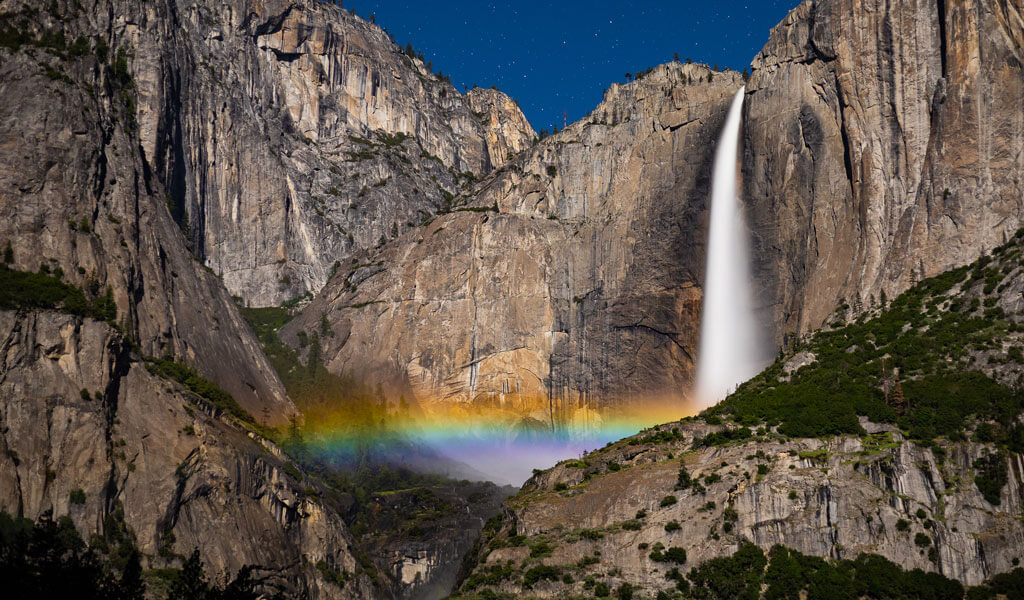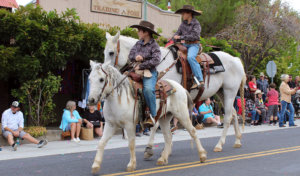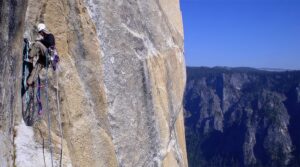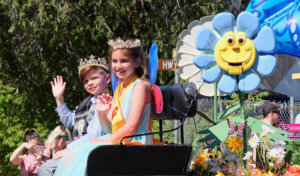As the high country snowmelt finds its way downward, and the waterfalls of Yosemite go from a trickle to a torrent in their plunge to the valley floor, a mystical (or shall we say mist-ical) phenomenon arises ““ the Yosemite moonbow.
Created by the rays of the moon instead of the sun, a moonbow occurs when light refracts in water droplets such as those rising from the thunderous mist at the base of Yosemite National Park’s unrivaled waterfalls. John Muir compared the moonbow to a religious experience, describing it as a “grand arc of color, glowing in mild, shapely beauty.” While the phenomenon is thrilling to behold, it also proves elusive. The conditions must be perfect, and for this reason, the Yosemite Moonbow inspires a legion of passionate pilgrims. Indeed, a worthy challenge for visitors seeking a once-in-a-lifetime experience.
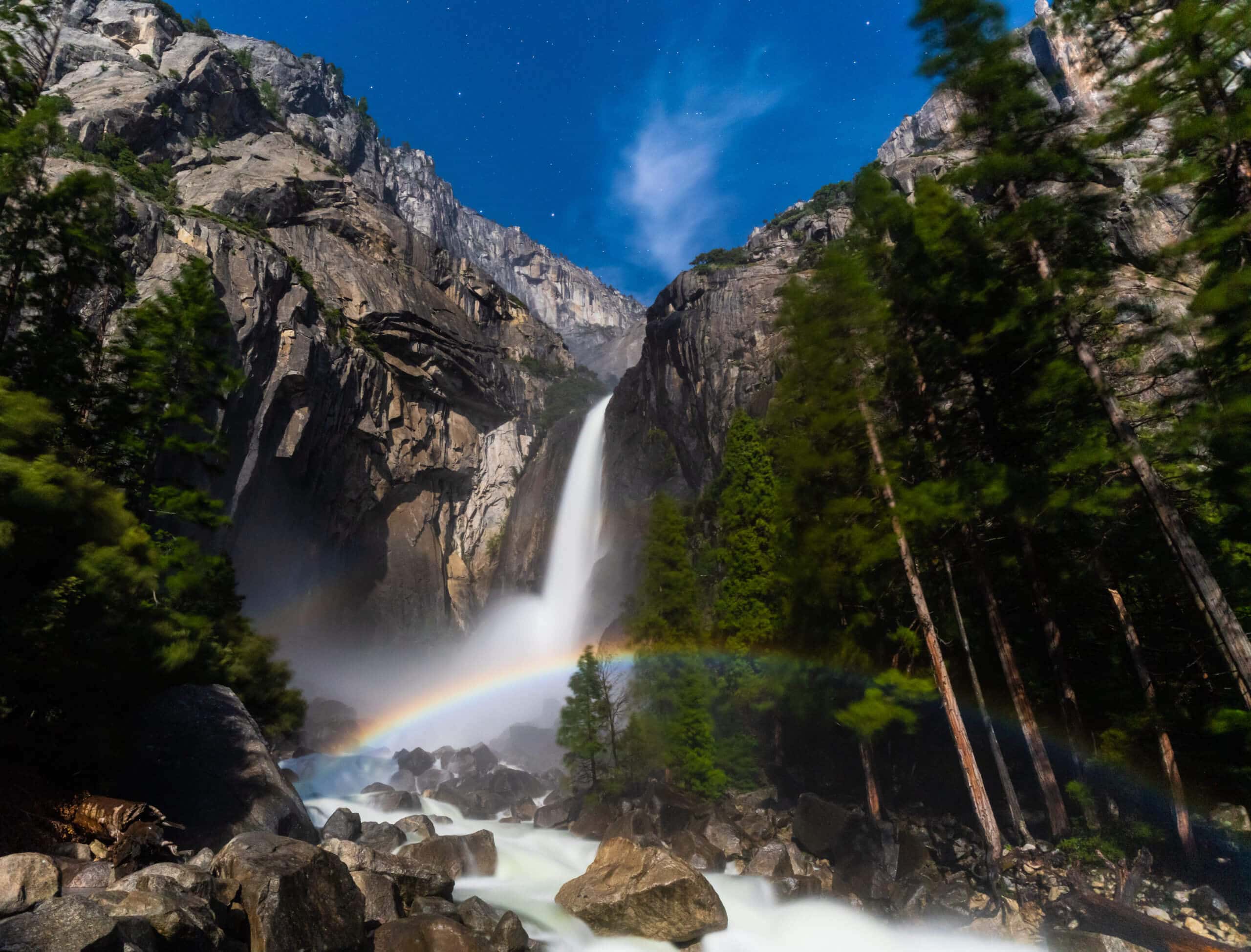
A Heaping of Moonlight, A Splash of Water, A Puff of Wind
Moonbows are no accident. It’s physics at work, conditions are key, and with a bit of preparation visitors to Yosemite National Park can greatly increase the odds of an unforgettable encounter. Here’s the recipe for success:
- a full, or nearly full, moon low over the horizon (an angle of 42 degrees or lower)
- a clear, optimally dark, sky
- mist from a majestic waterfall gushing with spring snowmelt (April-June)
- a swirling wind (optional, though it can enhance the effect)
With the growing popularity of moonbow hunting, some experts have refined their predictions for the best viewing. The calculations take into account a number of factors and can be incredibly helpful, but not the be-all-end-all. Whether one of these elusive phenoms is captured or not, a nighttime quest in one of the world’s preeminent national parks is indeed its own reward.
For a visual guide to seeing the moonbows in Yosemite, watch the Yosemite Nature Notes video below.
Seeing Is Believing
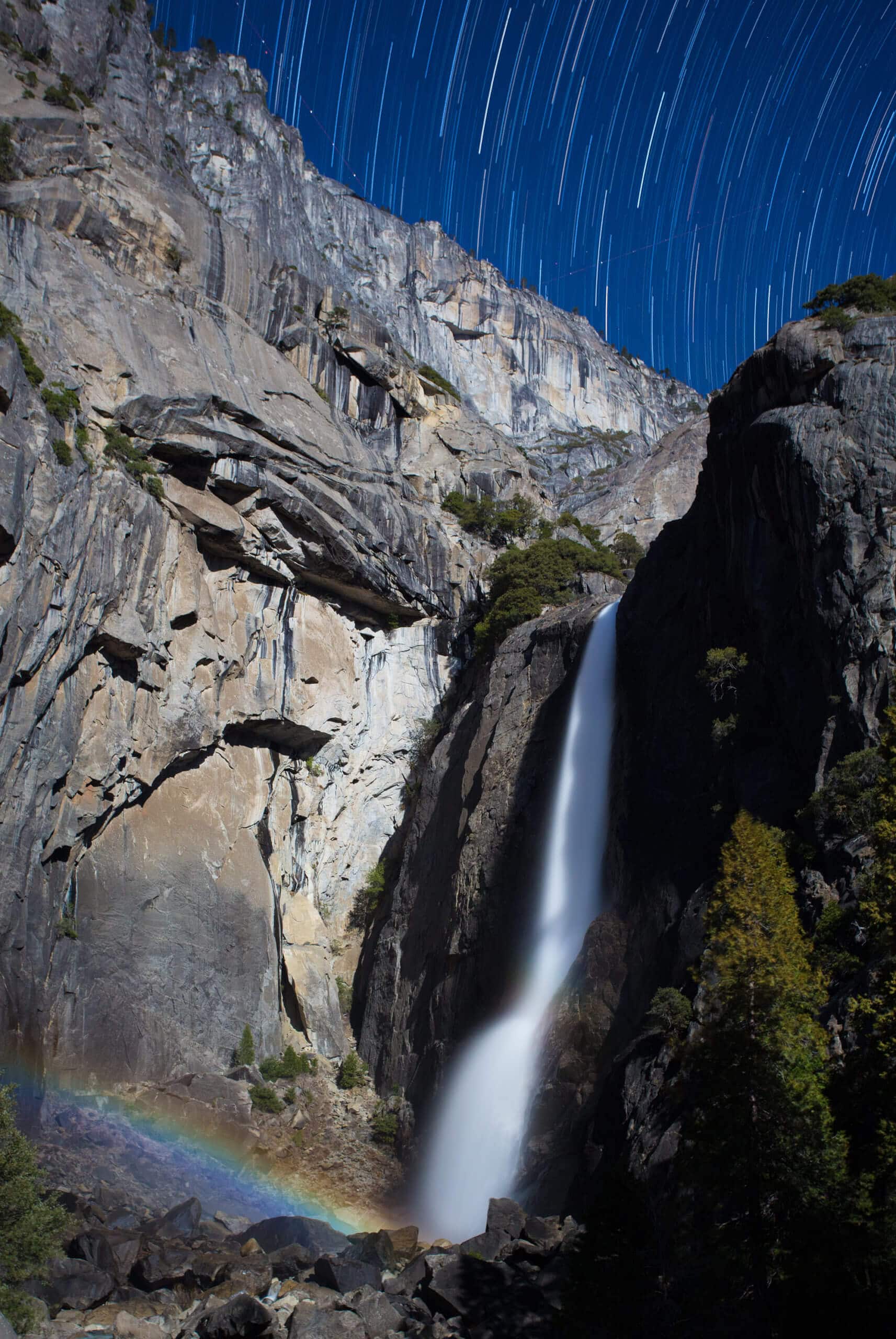
Moonbows can appear different when viewed with the naked eye. Those with excellent night vision can sometimes make out a faint spectrum of color, while most see a luminescent arc of whiteness spanning the mist. Though both are evocative, photography is the only fool-proof way to capture this ephemeral subject and for this reason dedicated photographers mark their calendars, gear up and strike out for their favorite waterfall. The results are self-evident all lead to one-of-a-kind shots, not to mention tales of Yosemite after-dark for those back home who want to know how it all magically came to pass.
There are countless online tips on how to snap the perfect image (shutter speeds, ISO, etc.), but of course, beauty is in the eye of the beholder. A few pointers, however, remain consistent when chasing moonbows. Bring a camera “” film or digital “” capable of manual focus and long exposures in low light settings, as well as a tripod to hold it steady. Bring a cloth to wipe mist off the lens, and a plastic bag to cover your camera. Remember to turn off your flash and, finally, be considerate of other photographers around you. The experience can be quite social, and good neighbors are more likely to become good friends and make a more enjoyable experience for everyone!
Yosemite Moonbow Guide
With one of the greatest concentrations of world-class waterfalls, Yosemite National Park offers lots of choices when it comes to picking a destination that matches your determination and fitness level. Whether it’s a three-mile, three-thousand-foot climb to Upper Yosemite Falls , or a car ride to Glacier Point, the excitement of exploring in the near-dark is both a dare and an opportunity. Forest shadows playing tricks, nocturnal sounds amplified without the competition of cars or crowds, not to mention careful footsteps which allow us to savor the distinct scents of damp moss and conifers. Setting out with only a flashlight to guide your way can be daunting, yes, but the reward is worth the effort.
Here are a few of those world-class choices:
Bridalveil Fall: an easy .5 mile round-trip hike with minimal elevation gain, this is the first waterfall visitors encounter when entering Yosemite Valley. The fall plunges 620 feet and is often windswept, which enhances the moonbow experience.
Lower Yosemite Fall: an easy 1-mile loop with minimal elevation gain, the footbridge at the base of Lower Yosemite Fall is one of the most accessible “” and popular “” vantage points in the Park for moonbows. There is lots of spray from its 320-foot drop so bring your waterproof shell and towels/bags to protect your camera.
Columbia Rock/Upper Yosemite Fall: one of Yosemite’s oldest trails, this strenuous 7.2-mile round-trip climb gains 2,700 feet to the top of the falls, but stop at the 2.5-mile mark (.5 miles past Columbia Rock) for a spectacular view of North America’s tallest waterfall (2,425 feet).
Cook’s Meadow: a bullseye for viewing all of the surrounding splendor, Cook’s Meadow begins at the Yosemite Valley Visitor Center and is a flat 1-mile loop providing a great vantage for moonbows at Yosemite Falls. A popular spot.
The Mist Trail (Vernal and Nevada Falls): a busy destination by day, The Mist Trail is little used at night. It covers a strenuous 5.4 miles round-trip and gains 2,000 feet to the top of Nevada Falls via a granite staircase. For an easier approach, the footbridge at the base of Vernal Fall is a moderate 1.6 miles round-trip accessed by a paved trail. The Mist Trail is aptly named for the waterfall mist that can blanket the trail, particularly in spring, so bring your shell and protection for your camera.
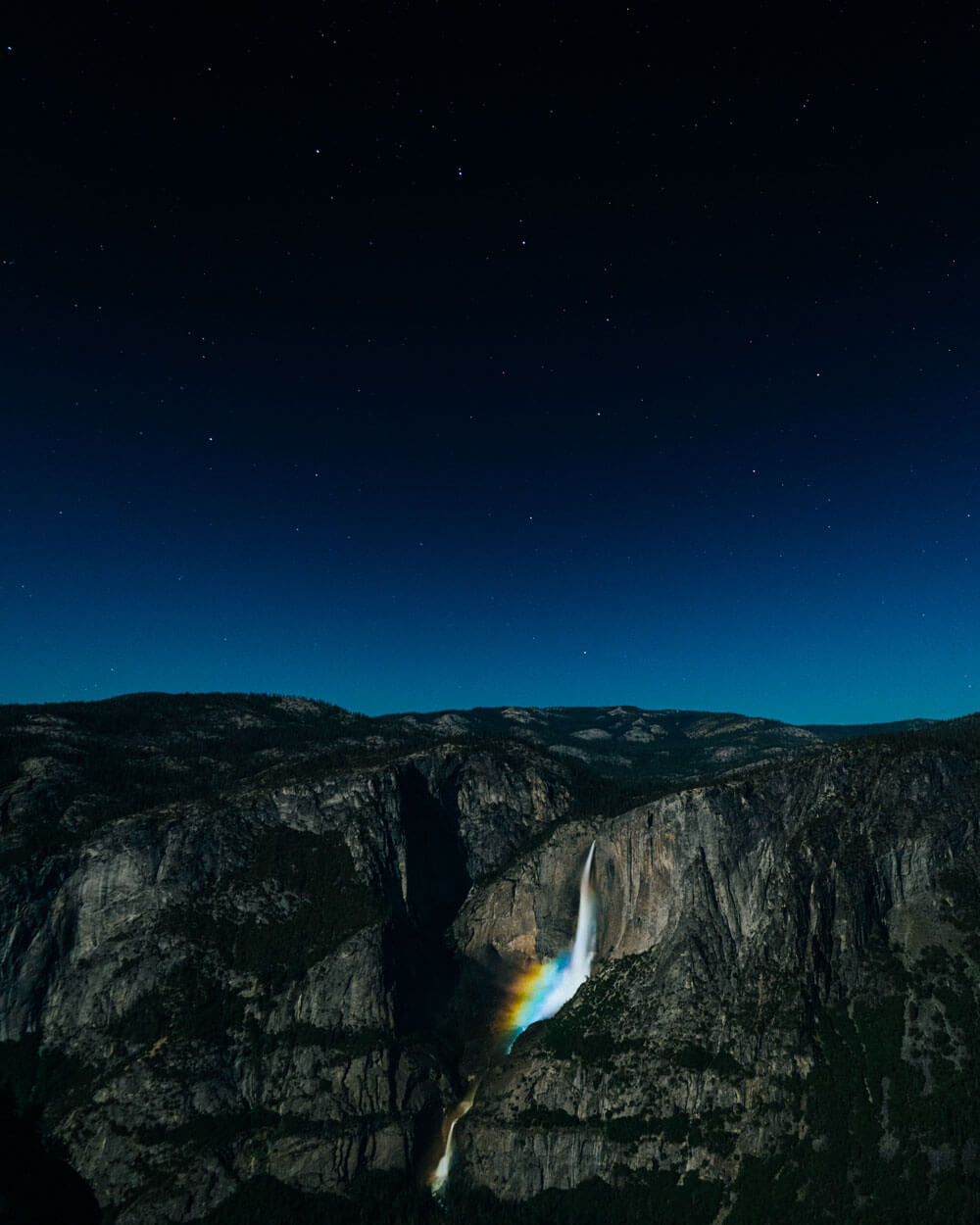
Glacier Point: an hour’s drive from Yosemite Valley, this paved vista is like looking down from heaven. With sweeping daytime views of Yosemite Falls, Half Dome and the High Country, Glacier Point is a staple of any Park visit yet moonbow sightings from this location can require patience. First, the access: Glacier Point Road re-opens in spring, typically late May to June which is when moonbows are at their peak. In addition, there’s a shorter nightly window for viewing as Yosemite Falls is farther away and thus the moonbow moves more quickly. But don’t give up! Photos here can be unrivaled with a little planning and if the stars align!
Ribbon Fall: though there isn’t a well-established trail, intrepid moonbow hunters might consider the base of elegant Ribbon Fall. At 1,612 feet, it’s the longest single-drop waterfall in North America but is often overshadowed by nearby Bridalveil and Yosemite Falls. The “trail” is strenuous “” 5 miles round-trip with an elevation gain of 1,160 feet “” and requires scrambling in sections. Ribbon Fall is fed purely by snowmelt and therefore its flow is seasonal, often drying up by mid-June. GPS and daylight scouting are definitely recommended.
Wapama Falls (Hetch Hetchy): this 5-mile round-trip hike starts at the O’Shaughnessy Dam on the Hetch Hetchy Reservoir and crosses several footbridges on its way to the impressive 1,000-foot-plus waterfall. In Spring, the wildflowers here are an added bonus. The Entrance Station leading to Hetch Hetchy Valley is seasonal (roughly corresponding with daylight hours) so plan your visit accordingly, i.e. an overnight stay in this peaceful corner of Yosemite National Park.
Whichever waterfall inspires you, moonbow hunters should always be prepared. Some essential gear to remember: layers, including a waterproof shell; hiking shoes with grip (the mist leaves the granite slippery); flashlight/headlamp with extra batteries; trail snacks; a thermos of your favorite hot beverage and a portable camp chair. If you’re heading off-the-beaten-path, it’s a good idea to scout your location during daylight if at all possible. If it’s tried-and-true, be sure to arrive early in order to set up.
Most of all, after the sun sets and the crowds have disappeared, enjoy the most peaceful after-party ever “” Yosemite at night. As William Shakespeare wrote:
The moon shines bright: in such a night as this,
When the sweet wind did gently kiss the trees
Like the Park itself, such a simple splendor. Happy moonbow hunting.

